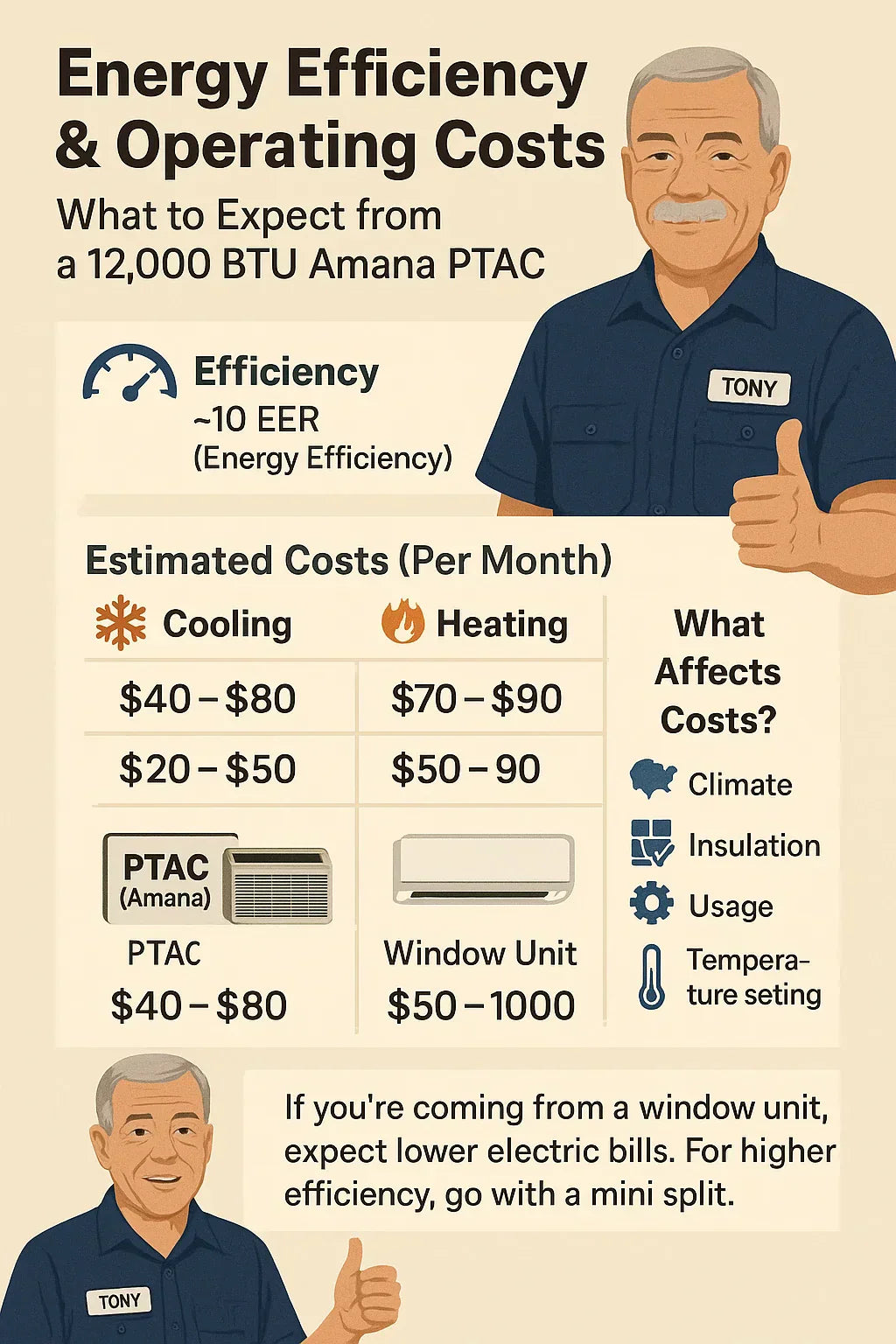When Tony upgraded the air conditioning in his guest apartment, his main goal wasn’t just comfort—it was lowering energy bills without sacrificing year-round reliability. His choice? The Amana Distinctions 12,000 BTU PTAC Heat Pump with 3.5 kW Electric Backup.
Like many homeowners, Tony had questions:
-
How much would it really cost to run?
-
Would the efficiency be good enough compared to a mini split?
-
And would it be cheaper than the old window AC?
This guide breaks down what efficiency ratings mean, real-world operating costs, and how the Amana PTAC stacks up against other systems.
🔍 Understanding PTAC Efficiency Ratings
Before Tony made the switch, he did his homework on how PTAC efficiency is measured.
📐 Key Ratings
-
EER (Energy Efficiency Ratio): Cooling efficiency → BTUs of cooling per watt of electricity.
-
COP (Coefficient of Performance): Heating efficiency in heat pump mode.
-
Backup Heat (kW rating): Pure resistance heating, less efficient but reliable.
👉 The Amana Distinctions PTAC has an average EER of ~10.0, meaning it provides 10 BTUs of cooling per watt.
That’s decent for a PTAC—higher than most window ACs, though still lower than ductless mini splits.
Reference: Energy.gov – Room Air Conditioners Efficiency Guide.
❄️ Cooling Efficiency: 12,000 BTU Amana PTAC
The cooling side is where PTACs shine, especially for small to mid-sized spaces.
-
Designed for 450–550 sq. ft. rooms (perfect for guest suites, offices, or apartments).
-
Average energy draw: ~1.2 kW/hour in cooling mode.
-
$0.19/hour to run in cooling mode.
-
Running 8 hours/day → ~$1.50/day.
-
Monthly cost (30 days) → ~$45/month in moderate summer use.
Tony compared this to his old 12,000 BTU window unit:
-
That one used ~1.5 kW/hour, costing closer to $55–$60/month.
-
The PTAC saved him ~20% on cooling bills right away.
🔥 Heating Efficiency: Heat Pump + 3.5 kW Electric Backup
The Amana PTAC isn’t just an AC—it’s also a heat pump with electric backup.
✅ Heat Pump Mode
-
Transfers heat instead of generating it.
-
30–50% more efficient than resistance heating (Energy.gov).
-
Works best above ~40°F outdoor temps.
⚡ Electric Backup Mode
-
Uses 3.5 kW/hour.
-
Costs ~$0.57/hour to run.
-
Runs only when outside temps drop below the heat pump’s range.
👉 Tony’s Ohio winters:
-
November–March → mostly heat pump use.
-
Backup heat ran about 10–15 days total in deep freezes.
-
Average winter bill increase: $70–$90/month, but only ~$15–$20 of that from backup heat.
For milder climates (South, coastal states), you may barely use backup heat at all—keeping heating costs low year-round.
📊 PTAC vs. Mini Split vs. Window Unit: Efficiency & Cost
Tony compared the Amana PTAC to other systems he had installed:
| System | Efficiency Rating | Cooling Cost (500 sq. ft.) | Heating Cost | Best Use |
|---|---|---|---|---|
| Amana PTAC | ~10 EER | $40–$60/mo | $70–$90/mo | Apartments, guest suites |
| Mini Split | 18–25 SEER2 | $25–$40/mo | $50–$70/mo | Whole homes, high-efficiency setups |
| Window Unit | 8–10 EER | $50–$80/mo | Limited (cool only) | Small rentals, short-term use |
👉 Reference: ENERGY STAR – AC Efficiency Standards.
🏠 Factors That Impact Operating Costs
Not all spaces are equal. Tony found that real-world costs vary based on:
-
Climate Zone
-
South: Cooling dominates costs.
-
Midwest/Northeast: Heating adds more.
-
-
Insulation
-
Drafty windows and poor insulation = higher energy use.
-
-
Occupancy
-
More people and appliances → more heat load.
-
-
Set Temperature
-
Every degree lower in summer = 3–5% higher energy use (Energy.gov).
-
-
Run Time
-
A PTAC in a guest suite costs far less yearly than one running daily in a primary living space.
-
🧮 Tony’s Real-World Bills
Tony tracked bills before and after switching:
-
Old Window AC (12k BTU):
-
Summer: $55–$65/mo (cooling only).
-
Winter: Space heaters ($100+/mo).
-
-
Amana PTAC (12k BTU + 3.5 kW backup):
-
Summer: $40–$50/mo.
-
Winter: $70–$90/mo (includes heat).
-
👉 Net result: Lower total energy spend and year-round comfort in one system.
🛠️ Tips to Lower PTAC Operating Costs
Tony discovered a few habits that make a big difference:
-
Clean Filters Monthly – keeps airflow efficient.
-
Seal Wall Sleeve Properly – prevents air leaks.
-
Use Low Fan Speed at Night – reduces both energy use and noise.
-
Program Thermostat Settings – raise temp a few degrees when away.
-
Regular Coil Cleaning – once or twice a year.
Reference: Amana PTAC Maintenance.
🏨 Why Hotels Love PTACs (and What That Means for You)
Hotels from Marriott to Hilton use PTACs like the Amana Distinctions because:
-
They’re efficient enough for one-room operation.
-
Provide independent comfort control per room.
-
Predictable operating costs per unit.
For homeowners, that translates to reliable performance and manageable bills in guest suites, offices, and apartments.
🎯 Final Verdict: What to Expect from the Amana PTAC
✅ Cooling costs: ~$40–$60/month in average climates
✅ Heating costs: ~$70–$90/month in cold climates (less in mild regions)
✅ Efficiency: Better than window units, not as high as mini splits
✅ Best fit: Guest suites, apartments, medium spaces
Tony’s advice:
“If you’re upgrading from a window AC, the Amana PTAC will cut your bills and give you heating too. If you want absolute top efficiency, go mini split. But for most homes, the PTAC hits the perfect middle ground—affordable comfort, year-round.”
In the next topic we will know more about: Maintenance Tips: Filters, Coils & Seasonal Care for Your Amana PTAC







